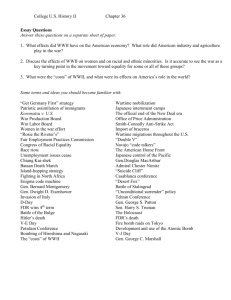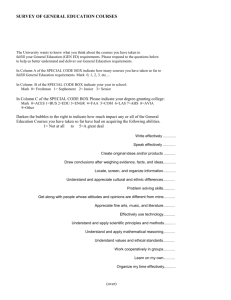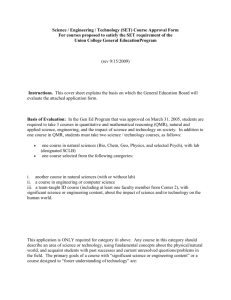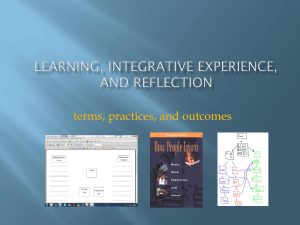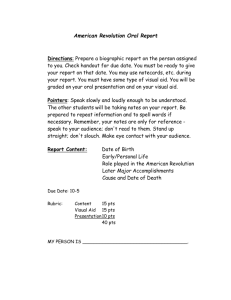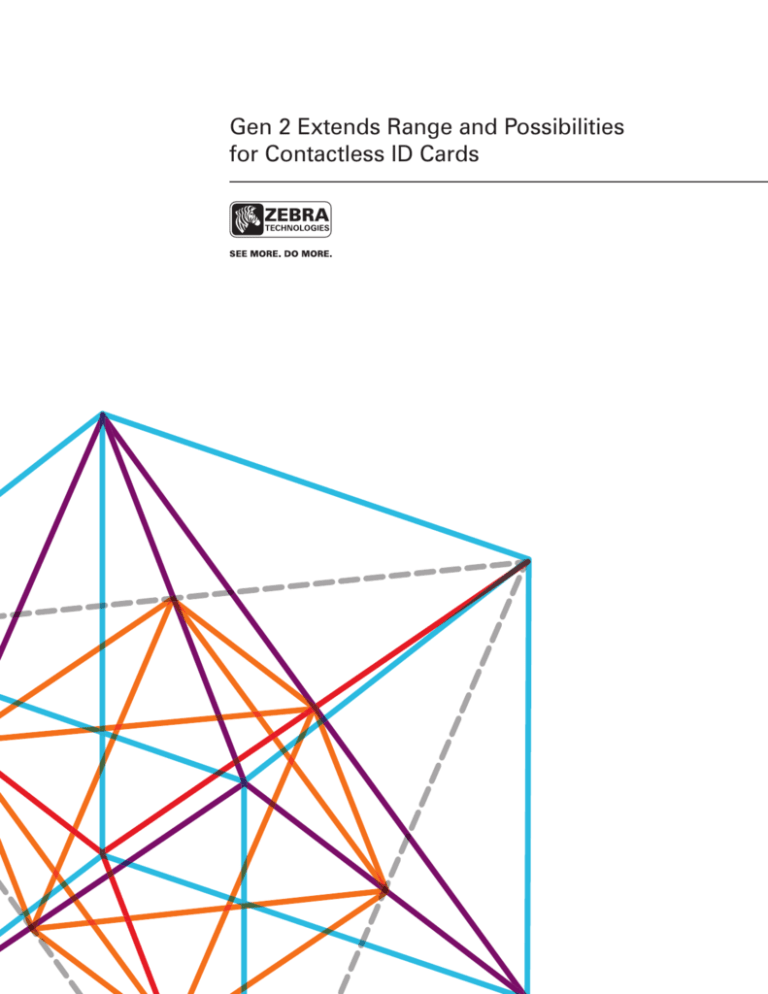
Gen 2 Extends Range and Possibilities
for Contactless ID Cards
EXECUTIVE SUMMARY
Contactless cards, tags and key fobs make life easier
for millions of people by providing a fast and
convenient way to open locked doors, enable cashless
payment at gas pumps and point-of-sale (POS) stations,
and eliminate the need to scrounge for tickets or exact
change for public transit fares. These applications have
also created misconceptions about what contactless
card technology is and what it can do.
Radio frequency identification (RFID) cards do not
need to be within a few inches of the reader to work,
as is the case in most cashless payment and access
control applications. Traditional contactless card
technology is very reliable and effective but is limited,
primarily because of the actual range of the radio
frequency (RF) signal. As the RF range of ID cards
increases, so does the potential application space.
Many users and system designers may not realize that
ID cards are readable from up to 50 feet away with
secure, standardized Gen 2 ultra-high frequency (UHF)
RFID technology. Only recently has it become
convenient and practical for organizations to print and
encode long-range cards in house—and now adoption
is flourishing. Long-range identification is especially
useful for many security, patron management,
customer service, and asset tracking applications.
Gen 2 and other UHF technologies remove many of
the limitations traditionally associated with contactless
ID cards but create new system-planning challenges.
This white paper explains how organizations can take
advantage of the range, speed, security, and memory
of Gen 2 RFID cards to create effective processes for
employee and customer identification, security, asset
management, and customer service.
INTRODUCTION
GEN 2 UHF TECHNOLOGY
Gen 2 technology holds an ironic position in the world
of ID cards. While not widely used for personal
identification, it is the technology behind some of the
largest, highest profile and most secure ID card
programs in the world. For example, the United States
Passport Card program uses Gen 2 RFID to increase
speed, efficiency and security at U.S. land and sea
border crossings and in potentially millions more
state-issued driver’s licenses.
Gen 2 contains all the elements for successful ID card
technology—it is secure, is standardized, supports
high throughput and is widely supported. Some of the
largest companies and public sector organizations in
the world use Gen 2 RFID systems for mission-critical
operations. Applications for personal identification
continue to grow rapidly for two main reasons. First,
organizations now have convenient options for
producing and issuing Gen 2-based ID cards.
A Zebra Technologies White Paper
Second, many people now realize they have a choice
of RFID card technologies and understand Gen 2
capabilities.
EPCglobal developed the Gen 2 standard so users
could accurately identify multiple items simultaneously
at distances not possible with legacy RFID technology.
EPCglobal submitted the technology to the
International Organization for Standardization (ISO),
which ratified Gen 2 as an international standard for
use worldwide.
Gen 2 sees widespread use for asset management
and product identification applications, where RFID
systems routinely identify and record an entire pallet
of goods automatically from unattended dock door
readers mounted 10 or 20 feet away. In fact, the
standard specification supports identification of more
than 1,000 tags per second.
2
Gen 2’s range and fast identification capabilities bring
significant benefits to ID card applications. For
example, Gen 2 range and speed eliminate the need
for single-file, one-at-a-time card reads. Groups of
people can move through large, open entry and exit
points, rather than having to pass through narrow
doorways, gates or turnstiles. Gen 2 technical
capabilities also support many new processes that
can improve security and convenience, detailed in the
Use Cases section of this document.
Table 1 highlights some of the biggest differences
between Gen 2 and traditional contactless cards. The
sections that follow present Gen 2 specifications and
performance characteristics as they apply to card
systems.
Table 1 – Select feature comparison of traditional and Gen 2 contactless card technologies
Traditional
Gen 2
Frequency
13.56 MHz (high frequency)
860-960 MHz (ultra-high frequency)
Range
1 to 4 inches
User selectable, up to 50 feet
Standards
ISO 14443A (MIFARE ), ISO 15693
EPCglobal Gen 2, ISO 18000-6C
Memory
1K standard, up to 4K
96 bits, up to 1K
®
Frequency
The Gen 2 standard specification supports RF
transmission in the UHF frequency band between 860
and 960 MHz. While Gen 2 technology affords
worldwide uses, the entire frequency range is not
available in every country because of different national
telecommunications regulations. In North America,
Gen 2 systems typically operate between 902 and 928
MHz. European systems operate between 865 and
867 MHz, and Asia tends to use the higher end near
960 MHz. Frequency is an important variable to how
RFID systems perform, affecting system range,
transaction speed, and also immunity to RF
interference caused by the physical environment.
Range
different antennas, which allow optimizations for
range, sensitivity, directionality, and other factors. The
same Gen 2 ID card may be readable from more than
50 feet away in one area but only from near contact in
another. The ability to set range gives system
designers tremendous flexibility. For example, imagine
an ID card that provides employee access both to the
company parking area and the building.
In this case, long range is desirable for the parking
area so the gate can open as the employee
approaches. To prevent unauthorized people from
entering just ahead of or behind the cardholder, ID
cards should not unlock more secure areas from long
distances. Variable range technology lets facility
operators set systems for the proper blend of security,
range and convenience.
The most obvious and dramatic difference between
Gen 2 and traditional contactless ID card technologies
is range. Gen 2 readers can identify standard, low-cost
cards without batteries from about 50 feet away
(actual range depends on the installation location and
other variables). Range for 13.56 MHz technology is
limited to a few inches.
Security
The range of any RFID technology depends on the
frequency and the amount of reader power that the
tag receives. Gen 2 users can adjust the range of their
systems by adjusting the power output and by using
Each Gen 2 chip contains a unique, preprogrammed
static ID number. Users can temporarily or permanently
encode additional data in the chip memory and apply
different levels of security to various memory blocks.
A Zebra Technologies White Paper
Security provisions in the Gen 2 standard include
multiple levels of data protection and device
authentication to prevent unauthorized reads. Several
security features are optional and require activation
during system setup.
3
By using the “permalock” feature, organizations can
lock data into Gen 2 chip memory to prevent
unauthorized users from overwriting data.
Another option is 32-bit password protection that
enables chips to be read or rewritten. Password
protection can be applied to all or part of chip
memory. Gen 2 chips can also be set only to
communicate to known readers, a valuable
authentication feature that helps prevent hacks and
skimming. Finally, many common IT and network
security protocols can be applied to networked Gen 2
readers and card printer/encoders.
Standards
Gen 2 is an internationally recognized standard, with a
full official name of “EPCglobal Class 1 Generation 2.”
EPCglobal is an international RFID technology standards
organization comprised mostly of end-user organizations
in a variety of industries. EPCglobal is part of GS1, a
leading international business process and technology
standards body that maintains the UPC/EAN system and
many other standards. For more information, see
www.epcglobalinc.org and www.gs1.org.
EPCglobal submitted its Gen 2 standard to the
International Organization for Standardization (ISO),
which ratified it as an official ISO standard, number
18000-6 Part C (commonly referred to as ISO 180006C). Gen 2 became an official standard in December
2004.
Support
Leading market research firm Venture Development
Corporation (VDC) reported that the total market for
Gen 2 UHF hardware grew by 140 percent from 2009
to 20101. The firm expects the total Gen 2 UHF market,
which includes transponders, readers and printers, to
grow by a compounded annual growth rate of nearly
60 percent through 2015, to $3.7 billion2.
1
2
The standard is widely supported by RFID device
makers and software developers, which gives
potential users a strong competitive market of
choices. Gen 2 has received strong support from
users and technology developers because it meets
the need for long-range, secure high-speed
identification, reliability, and cost effectiveness better
than alternative technologies and protocols.
Most of the billions of Gen 2 RFID tags deployed
include applications that identify assets and products,
not people. As noted, Gen 2 ID card systems are
growing in use in Gen 2-enabled ID cards and
documents. The U.S. government validated the
effectiveness and security of Gen 2 for personal
identification by selecting it as the technology for
Passport Cards, enabling fast and efficient land and
sea border crossings for U.S. citizens who frequently
travel to Mexico, Canada, the Caribbean and Bermuda.
As travelers approach the border control officer, a Gen
2 reader accesses a serial number on the Passport
Card from several feet away. The process begins a
secure database lookup. By the time the traveler
reaches the checkpoint, a computer screen displays
the traveler’s photo and pertinent information. This
allows the officer to quickly verify the traveler for entry
into the U.S. Prior to the Passport Card program, Gen 2
identification proved effective for border crossing and
security when used by commercial truck drivers as
part of the FAST, SENTRY and NEXUS programs.
After the Federal Government chose to use Gen 2 for
the Passport Card program, four states quickly
adopted the technology. Arizona, New York,
Washington and Vermont use the same technology for
their enhanced driver’s license (EDL) programs. The
Passport Card and state initiatives drive Gen 2-based
ID card usage into the hands of millions of U.S.
citizens. Today, Gen 2 inlays are inside every U.S.
passport card and every Green Card. As the following
section shows, the technology also enables a variety
of beneficial private sector uses.
VDC Research, “The Global Market for Gen 2 UHF Hardware”, April 2011.
Ibid.
A Zebra Technologies White Paper
4
USE CASES FOR GEN 2 ID CARDS
Many of the ways to benefit from Gen 2 ID cards may
not be immediately obvious. This is because users
traditionally lacked a cost-effective long-range option
and developed their applications and processes
accordingly. Better range, speed and memory improve
most identification processes, but Gen 2 ID cards are
especially beneficial when organizations want to:
• Relieve congestion or enable identification where
it is impractical to install a short-range reader
• Conveniently support a second form of identity
validation, such as biometric and facial recognition
• Provide high throughput entry/exit for convenience
and crowd control
• Automatically monitor specific zones and areas
• Associate people with assets
• Combine long-range identification with other
shorter-range applications, such as cashless
payment or access control
• Identify customers for loyalty and VIP programs to
enhance service and customer experience
• Link personal experience with emerging social
media platforms, automate “Check-Ins” and virtual
“likes”
Long-range reading can relieve congestion by
identifying, validating or counting multiple people
simultaneously, which also enables the use of larger
exits and entryways. Extended range is also beneficial
when the reader does not afford easy installation at the
desired read point. Benefits extend to when it is
advantageous to identify a person before he or she
reaches a specific location, such as in the Passport
Card program.
Parking gates provide a more common example of the
convenience that extended read range provides. UHF
ID cards or parking passes on vehicles drive user-friendly systems that raise the gate so the driver does not
have to stop. Because the read range is customizable,
long-range identification applications can be combined
with other short-range applications using the same UHF
ID cards.
Extended-range identification is also an excellent way
to monitor an area to count passers-by or monitor
traffic flow. For example, a museum could issue its
patrons RFID-enabled ID cards and install readers
throughout the facility to count how many people visit
different wings and exhibits.
Gen 2 readers find common use in monitoring zones
for security and asset management applications.
Whenever a tagged item enters or leaves the zone, the
tracking system records the action and can issue alerts
if asset movements are suspicious or fall outside set
guidelines. For example, data centers often use Gen 2
to track laptops, servers and other IT assets.
With Gen 2 ID cards, RFID infrastructures can leverage
exiting zone monitoring, and security departments can
enhance the processes to improve asset tracking and
worker convenience. For example, using Gen 2 on
items and ID cards enables accurate, unattended
dispensing of tools, equipment and other assets, and
other automated check-in/checkout procedures.
The sections that follow provide more detailed use
cases for how long-range ID can improve common
business processes.
When a Passport Card holder reaches the front of the
line, the border control officer’s computer screen
immediately displays the entrant’s picture, resulting
from the UHF card read that took place several feet
away. The photo provides another form of identification
for the officer to validate when checking credentials.
A Zebra Technologies White Paper
5
SECURITY
Gen 2 ID cards used today to secure U.S. borders by
verifying U.S. travelers, commercial truck drivers and
their vehicles support easy adaptability for private
sector use. The results are applications that provide
high security or add convenience to access control
operations.
For high-security access control, businesses can use
long-range contactless ID cards, together with biometrics, video surveillance and other technologies, to
create layered protection. In standard contactless
access control, the RFID reader looks up the unique
card identification number to trigger a database check
to determine cardholder access. Higher-security
systems transcend basic card authorization by retrieving a photo record of the authorized cardholder (as in
the Passport Card program). Sophisticated systems
can also direct a camera to capture an image of the
person for identification by a biometric technology
such as facial recognition.
Longer-read range is beneficial for sophisticated
security systems because the earlier read allows more
time for the system to retrieve the photo image,
allowing fast inspection by a guard. Gen 2 provides
various memory blocks for ID card programing that
specify different levels of access control. For example,
a worker may have 24-hour access to the building but
can be restricted from entering high-value storage
areas, secured archives, or other sensitive areas
during his or her normal working hours.
Increased range provides benefits even when added
security is not a requirement. For many facilities,
increased range provides increased convenience. With
Gen 2, the system can identify employees as they
approach the door so it unlocks just as they arrive. The
result is a faster access instead of presenting an ID
card to a wall-mounted reader then waiting for a door
to open. Another example is in employee parking lots.
Long-range Gen 2 allows cars to pass without having
to stop and wait for the gate to rise.
More range also means more options for portals.
Because systems can identify and verify people from
50 feet away, they do not have to pass through small,
inflexible areas. Long range provides flexibility for
designing areas that reduce congestion. The UHF
frequency band can complete successful reads
through drop ceilings, allowing reader installation in
discrete and aesthetically pleasing locations.
Traditional card-based time and attendance systems
can also use Gen 2 cards. Now that organizations have
the ability to conveniently produce Gen 2 employee ID
cards in house, this application will experience
significant market growth.
LONG-RANGE IDENTIFICATION
Area coverage can save valuable time—and lives—
during emergencies and is a key enabler for emerging
long-range tracking applications. RFID sees
widespread use for tracking workers in dangerous
environments, such as mines or areas where exposure
to chemicals, gases or radioactivity requires
monitoring. Traditionally, these systems use batterypowered active RFID tags, which can cost $100 a
piece. Because of the cost, deployment has mostly
been limited to select high-risk environments. The
development of standardized Gen 2 technology makes
it practical to extend wireless area monitoring into
many additional environments because readers and ID
cards cost less.
A Zebra Technologies White Paper
Gen 2 readers afford easy outdoor or indoor
installation, enabling diverse applications for
managing workers in hazardous and disaster
environments. Workplace regulations limit the amount
of time workers can spend in a hazardous
environment, such as where low-level radiation is
present. These cases are excellent opportunities for
installing readers to cover the area and automatically
record all entries and exits. System software can track
the amount of time each individual worker spends in
the area, calculate real-time cumulative totals, and
automatically generate alerts (by e-mail, pager or even
alarm) as workers near their time thresholds.
6
Using RFID completely automates the data entry and
calculation processes and can automatically generate
and store necessary records. A network of readers
covering rooms, labs, test facilities, tunnels,
mineshafts and other areas can produce a real-time
view of employee locations—information that is
invaluable in case of emergency.
The same application principles apply to nonhazardous environments, where administrators require
accurate, real-time information about where people
are in the building or campus. These environments
include hospitals, assisted living residences, schools,
daycare centers, and other facilities where
administrators are responsible for the custody and
safety of residents, patients, visitors, and guests.
For example, a school could use Gen 2 staff and
student ID cards to take automatic attendance daily,
saving time for teachers and eliminating the need for
office staff to manually enter attendance data into the
computer records system. The key benefit is the
system’s ability to provide dynamic, updated
information. Traditional attendance systems provide a
record of who was in the building at the start of the
school day. RFID systems can track students during
an evacuation and in day-to-day operations. The result
is a real-time location record of each student and staff
member at all times by using RFID readers to monitor
classrooms, hallways, playgrounds and other areas.
Alerts could be issued when students attempt to enter
restricted areas or leave the campus at unauthorized
times. This added visibility of student movement also
extends to school buses and other vehicles to ensure
and/or confirm where and when students boarded and
exited the vehicles. There is precedent for these use
cases, as RFID wristband and ID card systems are
already widely used in hospitals to prevent infant
abduction and to detect patients wandering from
Alzheimer’s and psychiatric wards. Another application
includes RFID card systems installed at prisons and
security services to monitor guard locations.
PATRON MANAGEMENT AND CUSTOMER SERVICE
Customer service and patron management
applications revolve around Gen 2 loyalty cards,
passes or badges. The simplest application is to track
the movement of people through the facility. RFID
tickets, cards and passes are becoming increasingly
popular at ski resorts to control access to lifts and to
provide operators with up-to-date information about
where skiers are on the mountain, which can be
life-saving knowledge during an avalanche. In addition,
resorts are using RFID to enhance the skier experience
by enabling them to capture information, connect with
fellow skiers, and share through social media
networks.
Retailers could analyze cardholder location data to
determine how much time customers spent in various
areas of the store and to collect insight on what types
of merchandising and displays were effective. The
next level includes building a simple application that
communicates alerts or exception notices triggered
A Zebra Technologies White Paper
when particularly high traffic in a specific area occurs
so the retailer can deploy resources. This application
is well suited to large retail areas, such as garden
centers and warehouse clubs, where managers lack
visibility into the entire facility. Real-time customer and
location data also enables customized interactive
marketing, where ID card reads trigger in-store
multimedia displays or kiosks to promote special
offers or services based on customer profiles.
These applications are not limited to retail. The ability
to redeploy staff based on customer or guest
locations is especially valuable to resorts, theme
parks, cruise ships, museums, clubs, sports and
entertainment venues, exhibit halls, and other service
and hospitality environments. Businesses can tailor
applications to serve VIPs and top customers or for
general operations to ensure beverage, food service,
merchandise, ticketing and service areas remain
adequately staffed.
7
ASSET PROTECTION AND MANAGEMENT
This white paper has highlighted how proven RFID
applications can be adapted and enhanced by using
Gen 2 ID cards. Asset management operations
represent some of the best opportunities for
improvement. RFID asset tracking applications
typically provide complete return on investment (ROI)
in less than ten months—the fastest of any
application. Combining asset management with other
applications, such as ID and security, reduces the ROI
period even more.
Billions of low-cost Gen 2 labels and tags are already
in circulation, and thousands more are applied every
day to track computers, tools, equipment, returnable
containers, files, evidence, samples, raw materials,
finished goods and other assets. Portal readers
automatically record each time employees remove
and return tagged assets. These systems provide data
on assets that are in use but no information about
who is using them. While traditional processes
allowed manual asset sign-out, these processes are
notoriously inaccurate and out of date. The honor
system has its own set of problems: Multiple studies
have found business lose much more due to
employee theft than they do to shoplifting.
Companies can leverage existing asset tagging
systems to gain another level of visibility by
integrating Gen 2 ID cards so assets can automatically
associate with the people who remove or use them.
The system does so by simultaneously and
automatically reading the asset tag and ID card and
applying a date stamp to the readings. The transaction
then associates the asset with an individual, which
builds accountability into systems and reduces time
spent searching for assets that are in use. Leading
applications include fleet management, document
management and tool crib systems.
Delivery businesses can set up fleet management
applications to use RFID for identifying any
combination of employees, keys or vehicles. For
example, a worker may use an RFID employee ID card
to sign out the keys to a company vehicle. The vehicle
itself could include an RFID tag that is read each time
it enters and exits the parking area. Data from these
read points provides real-time status information
about which vehicles checked out and which vehicles
A Zebra Technologies White Paper
are currently available on the premises. The data
enables automatically created historical records for
analyzing asset utilization, plan predictive maintenance,
and track vehicle use by individual employees.
Document tracking applications can verify the current
location of important documents at all times. Law
offices can associate documents with a lawyer’s ID
card to assist in time billing. In courthouses, clerks can
move documents to the right courtroom on time and
by authorized personnel only.
Automated tool crib and dispensing systems that
feature technology-enabled automatic checkout and
return have been available for years. Now the practice
can be extended to many other types of assets
because it is relatively easy to implement long-range
ID cards and area-monitoring systems.
Integrating asset tracking with personal ID also helps
avoid time-wasting asset searches. Instead of walking
around a shop floor, warehouse or office to find who
has a particular piece of equipment or file, workers
can simply consult a computer screen to see who
signed it out. Speeding the search process cuts
unseen costs from operating expenses. For example,
if employees spend an average of only ten minutes a
day looking for tools, equipment or materials, they
spend the equivalent of one full week each year on
non-value added searching, as the following
calculation illustrates:
(10 minutes/day x 5 days/week x 50 weeks/year) =
2,500 minutes/year ÷ 60 minutes/hour =
41.67 hours.
To find the labor cost of searches, multiply this time by
the number of employees involved in searches and by
their average hourly salary. Actual costs incurred
because of incomplete asset tracking are actually
higher because the department cannot utilize missing
assets, and they often require replacement.
There are numerous ways to use Gen 2 tags and ID
cards to automate check-in/checkout, asset
protection, chain of custody and other operations.
Learn more about RFID, card and related technologies
at www.zebra.com.
8
SUMMARY AND CONCLUSION
By extending read range from inches to feet, Gen 2
UHF technology increases the potential uses for ID
card applications and the convenience and security
benefits they provide. However, no technology—
including Gen 2—is optimal for all ID card systems
and user needs. The most effective systems take
advantage of capabilities to support the organization’s
desired business processes to maximize safety,
security and convenience for employees, guests and
customers. Organizations can begin to consider new,
longer-range processes to meet these needs now that
secure, standardized Gen 2 technology is available in
easily produced ID cards.
Zebra Technologies offers the most robust product
line of RFID printers and encoders in the industry—
manufacturing and delivering thousands of ID card
printers that support traditional high-frequency RFID
encoding. Zebra was the first company to offer Gen 2
encoding integrated on the card printer. UHF-enabled
models use the same printer drivers and ribbons as
the non-UHF models. The only requirement for RFID
encoding is ID cards with embedded UHF Gen 2
chips—which Zebra also designs—ensuring total
solution compatibility.
A Zebra Technologies White Paper
The cards support all EPCglobal Gen 2 and ISO
18000-6C RFID security standards and provide 96 bits
of password-protected memory. Enterprises can use
Zebra’s UHF- enabled printers to create non-RFID ID
cards and maintain all their standard features,
including support for magnetic stripe encoding,
barcode printing, full-color printing and support for a
variety of card materials.
A global leader respected for innovation and reliability,
Zebra offers technologies that illuminate organizations’
operational events involving their assets, people and
transactions, allowing them to see opportunities to
create new value. We call it the Visible Value Chain.
Zebra’s extensive portfolio of marking and printing
technologies, including barcode, RFID, GPS and
sensoring, turns the physical into the digital to give
operational events a virtual voice. This enables
organizations to know in real-time the location,
condition, timing and accuracy of the events occurring
throughout their value chain. Once the events are
seen, organizations can create new value from what is
already there.
For more information about Zebra’s solutions, visit
www.zebra.com.
9
Corporate Headquarters
+1 800 423 0442
inquiry4@zebra.com
Asia-Pacific Headquarters
+65 6858 0722
apacchannelmarketing@zebra.com
EMEA Headquarters
+44 (0)1628 556000
mseurope@zebra.com
Latin America Headquarters
+1 847 955 2283
inquiry4@zebra.com
Other Locations / USA: California, Georgia, Illinois, Rhode Island, Texas, Wisconsin Europe: France, Germany, Italy, the Netherlands, Poland, Spain, Sweden, Turkey,
United Kingdom Asia Pacific: Australia, China, Hong Kong, India, Indonesia, Japan, Malaysia, Philippines, Singapore, South Korea, Taiwan, Thailand, Vietnam
Latin America: Argentina, Brazil, Colombia, Florida (LA Headquarters in USA), Mexico Africa/Middle East: Dubai, South Africa
©2013 ZIH Corp. Zebra and the Zebra head graphic are registered trademarks of ZIH Corp. All rights reserved. All other trademarks are the property of their
respective owners.
P1059935 (03/13)



